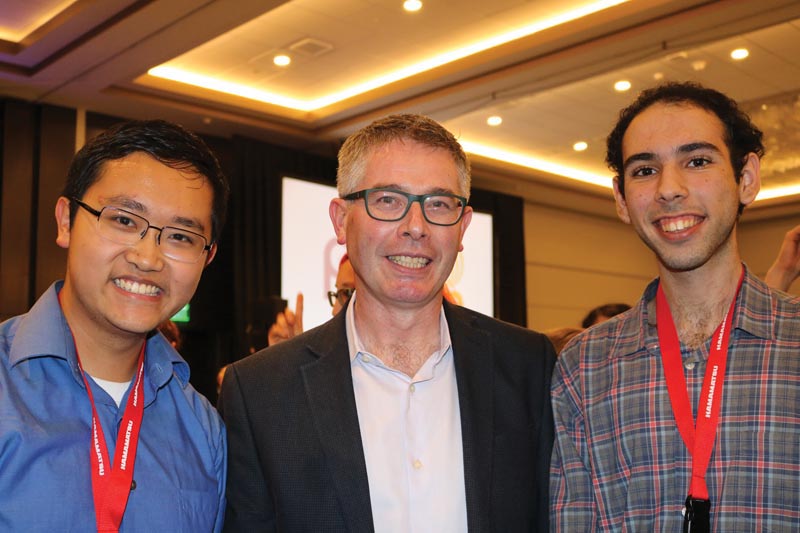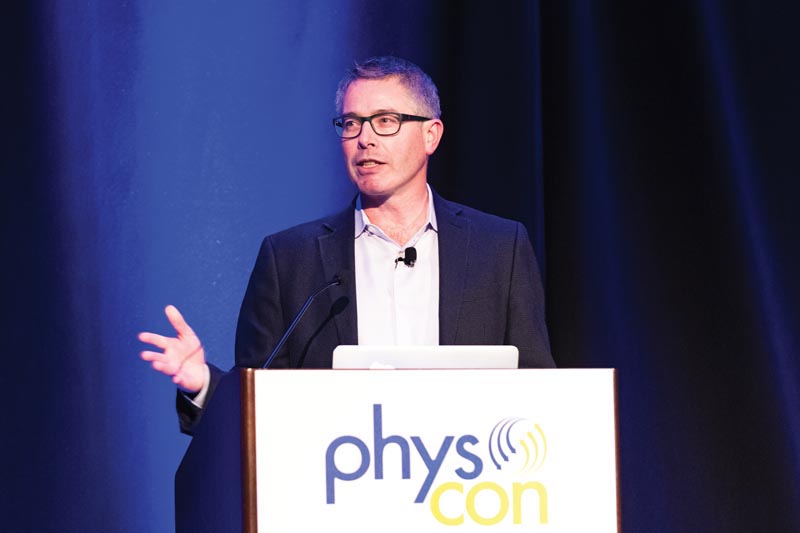Making Waves at PhysCon: The Detection of Gravitational Waves
Spring
2017
Special Feature
Making Waves at PhysCon: The Detection of Gravitational Waves
Chunyang Ding, Suryabrata Dutta, and Mehmet Tuna Uysal, SPS Reporters, Yale University
Yale University

The detection of gravitational waves from the collision of two 30-solar-mass black holes made international headlines when it was announced last year, confirming a fundamental prediction of Einstein's theory of gravitation. With a detection accuracy of one part in one thousand thousand thousand million, the Laser Interferometer Gravitational-Wave Observatory (LIGO) collaboration saw the "chirp" of two black holes—roughly 1.3 billion light years away from Earth—merging together. Dr. Patrick Brady, director of the Center for Gravitation, Cosmology and Astrophysics and a professor at the University of Wisconsin, Milwaukee, gave the closing plenary at PhysCon on his work with LIGO as a former director.
Before the talk and throughout the weekend, several plenary speakers, including Dr. James Gates, Dr. Neil Turok, and Dr. Jocelyn Bell Burnell, alluded to how gravitational waves would transform both experimental and theoretical physics. "I've followed gravitational wave research for 45 years. I knew it would be difficult to detect. I wasn't sure it would happen in my lifetime; I'm delighted it has," said Dr. Burnell, the honorary chair of PhysCon. Undergraduates at the conference shared in this excitement and were eager to hear about the discovery.
The detection of gravitational waves has already been heralded as one of the most profound discoveries of the decade. Gravitational waves were first predicted by Einstein's theory of gravity as energy that dissipates through accelerating masses, but even Einstein thought they would remain forever undetected. Detecting the gravitational waves from a black hole merger event requires a precision equivalent to measuring the distance from Earth to the star Alpha Centauri down to the width of a single human hair. To perform this ultraprecise detection, physicists Rainer Weiss of MIT, Kip Thorne of Caltech, and Ronald Drever of Caltech designed a laser interferometer, something that can measure tiny disturbances using laser interference patterns. While simple in principle, the actual instruments—one in Hanford, Washington, the other in Livingston, Louisiana—have arms stretching out 4 kilometers.

In his talk, Dr. Brady provided an in-depth exploration of the science that led up to the detection of the gravitational wave on September 14, 2015, paralleling the timeline of human events with the approximate location of the gravitational wave. He pointed out that as humanity first began to use stone tools 2.5 million years ago, the gravitational wave was passing through the Andromeda galaxy; as Newton first described gravity 329 years ago, the wave had passed by the Pleiades; as the advanced LIGO project was coming online, the gravitational wave had already entered our solar system.
Dr. Brady spoke at length about the many physicists whose research was instrumental in this detection, showing that physics is a huge collaborative effort. The LIGO collaboration alone has a thousand scientists across 80 institutions and 15 countries. Even though Dr. Brady is one of the leaders of this discovery, he remains humble. "I feel really lucky that I got the chance to be part of the team," said Dr. Brady.
Throughout the talk, Dr. Brady frequently returned to the human aspect of the research, encouraging the crowd of young scientists to pursue their dreams, whatever they are. He peppered the history of the great physicists of the 20th century with remarks about his own childhood, and frequently nodded to other PhysCon speakers, especially the talks by Dr. Jocelyn Bell Burnell and Dr. Persis Drell and their remarks on diversity. In the closing minutes of the plenary, Dr. Brady charged all students to seek out diverse collaborations. "This isn't about us as individuals. This is about us as a group, this is about us as a society," he said, receiving thunderous applause from the audience.
The future is bright for gravitational-wave detection opening a new spectrum for fundamental physics and astronomy observations. The detection of large black hole merger events is already shaking up our understanding of black holes. As new interferometers come online in the future, they will provide more and more discovery opportunities for physicists around the world.
Throughout the 2016 PhysCon, students were challenged and encouraged by the speakers to be creative thinkers, passionate about solving physics mysteries. “My opinion is that there are lots and lots of interesting things to do and to learn in this world,” said Dr. Brady. "Don't latch onto one too early. Realize that you have options, and when you are doing one, focus on it, and you'll do well."
See the full version of this article.
